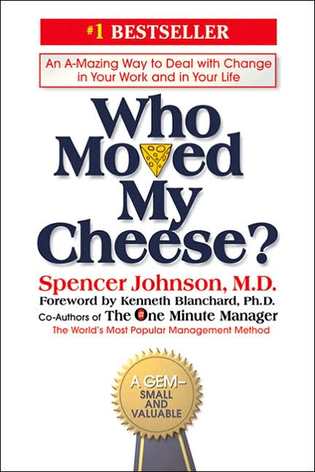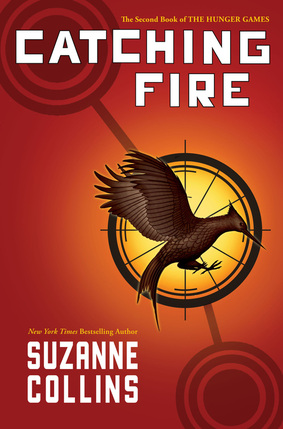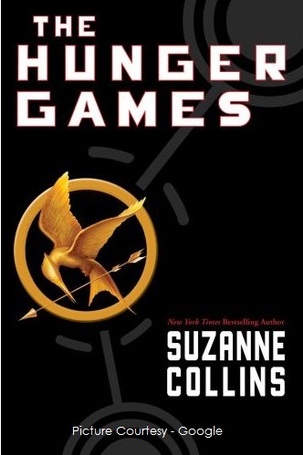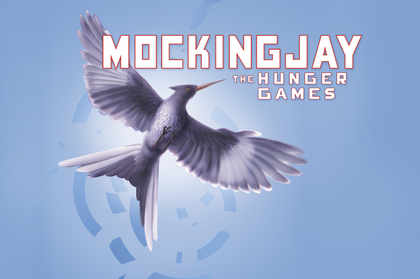Author : Spencer Johnson
First Published : September 8th 1998 by Putnam Adult
ISBN 13 : 9780091883768
Genre : Motivational / Self help
Reviewer’s rating : 5/5
 Photo Courtesy : Google Images The book was originally titled ‘Who Moved My Cheese? An Amazing Way to Deal with Change in Your Work and in Your Life’ and has proved to be true to its title by almost everyone who has read it. It is a simple parable told in less than 100 pages, most of which has just a picture of cheese with a saying on it. But it’s not just the length of the story that will make the reader like this book. Who Moved My Cheese is one of those books that everyone can relate to. The story is based on the very fact of life that we all succumb to at some point in our lives: change. In work, as in life, we all face changes that we find hard to accept or deal with. Although the sentence “this book changed my life forever” is as fraudulent as it sounds, books certainly help in giving a new perspective to the way we approach the changes in our life. ‘Who Moved My Cheese’ is one such book that will make you think without putting too much pressure on your head.
It’s a story about four characters: two mice named Sniff and Scurry, and two little people or miniature human beings named Hem and Haw. Allegorically, these four stand for the ways in which people deal with the difficult situations in their lives. They are placed in the maze of life, searching for the cheese which is the thing that gives them happiness. When the Cheese that these four were very comfortable with suddenly vanished, their reactions were very different. While Sniff and Scurry (who had already anticipated the change) moved on, Hem and Haw felt dejected and grief-stricken. The response of Hem and Haw is what most readers would associate themselves with.
Through the course of the last 40 pages, Spencer Johnson succeeds in his work of providing an ‘amazing way to deal with changes....’
One of the very interesting parts of the book is the sayings that Hem writes on the walls. The most effective line among those is: 'What would you do if you weren't afraid?' This is what we essentially need to ask ourselves when we face a dead-end and don’t know what to do. The characters of Sniff, Scurry, Hem and Haw are beautifully constructed to serve the purpose of the book.
‘Who Moved My Cheese’ is considered one of the best selling business books. It has sold more than 26 million copies worldwide in 37 languages. Many companies hold reading sessions of the book for their employees, thereby providing them with new ways of looking at their professional setbacks. The story, as the title says, doesn’t just stay constricted on professional front. It helps in dealing with all sorts of changes one may encounter.
So go ahead and grab the book because by the end of it, you'll have a smile on your face and a picture of New Cheese in your heart!
Happy Reading! :)
Mansi Sharma
Columnist
Author: Cecelia Ahern
First Published: January 1st, 2008 by Harper Collins Publishers Ltd
ISBN: 9780007233687
Genre: Adult Fiction, Contemporary, Romance.
Setting: Dublin, Ireland.
Narrative: Two narrators, both first person.
Reviewer’s rating: 5/5
There are books that take the reader to a path breaking journey, at the end of which, the reader comes out shining; brighter and better than before. They tell you that you should always look at the brighter side of every situation you are in and how beautiful life is, even if everything that you believed in is lost. These
self help books have probably changed the minds of all those people who’d have jumped off the roof had it not been for these books. Thanks for the Memories by Cecelia Ahern is definitely not one of them. It doesn’t change your life or professes that life is the most beautiful thing to have ever happened to mankind. Yet, it makes the reader appreciate it, even if she/he thinks it’s not worth it.
Thanks for the Memories has two parallel stories looking for one common destination. An Irish woman Joyce Conway has just had a heap of disturbed times in her life. She's going through the loss of her unborn child and a failed marriage. Her miscarriage puts her life in danger because of the loss of so much blood. Add all those sorry faces that she has to face; her life is in a very clear mess.
An American man Justin Hitchcock, who has moved across the country just to be close to his daughter Bea, is recovering from his divorce. He is an art and architecture freak, knows Latin and Italian besides a great knowledge about Renaissance paintings and architecture. He comes to Dublin as a guest lecturer and has to donate his blood just to get in the good books of this gorgeous doctor Sarah. This blood saves Joyce's life when she has the miscarriage. After the blood transfusion, Joyce learns Latin and Italian overnight; apart from the detailed knowledge about the paintings and architecture. The rest is for you to find out!
This is one book that I just didn't want to have an end. The story won’t tell you new things. It won’t leave you with an ‘eyes-popping and jaw-dropping’ face of a newly recognized profound revelation. It is an amazing story which would make you laugh and smile through the tears. The best character of the book is Joyce’s 75 year old father, whom you’d love so much that you’d want to rip him out of the paperback and hug him tight! He’d make you laugh your hearts out! This fiction, ironically, will help you a great deal in going through the reality and not to forget, a better understanding of life and death and everything in between!
So, happy reading and carry a pencil to mark the beautiful sentences you’d find every now and then that I’m sure you’d want to remember for a long, long time.
- Mansi Sharma
UE Correspondent
Author: Suzanne Collins
First Published: August 24th, 2010 by Scholastic Press
ISBN: 0439023491 (ISBN13: 9780439023498)
Series: The Hunger Games #3
Genre: Dystopia, Young Adult.
Setting: Post-apocalyptic North America. A nation called Panem.
Narrative: First person, present tense.
Reviewer’s rating: 5/5
If there’s a word that sums up feeling totally drained, broken, but at the same time hopeful, that's the story of Mockingjay in a nutshell. Like the previous book of the series, Mockingjay begins at a slow pace. The previous book of the series ended with a shocking information from Gale: there is no District Twelve. Mockingjay comes with even more cliffhangers. The story begins when the rebellion has finally started. The long gone and dead District Thirteen emerges from the underground, quite literally. And with them comes yet another pair of people Katniss finds hard to trust.
Katniss Everdeen has survived yet another Hunger Games; against the wishes of the Capitol, against the wishes of her own. District Thirteen has come out open with a plan. The Head Gamemaker Plutarch Heavensbee is on the Rebels side. While the District has been training their soldiers and the refugees from Twelve, Plutarch is coaxing Katniss to be the Face of the Rebellion. There’s only one purpose she has to serve and that is to be the Mockingjay, the symbol of the Rebellion which gives hope to the Districts.
If words could kill, you’d die a hundred times over in this book. You can’t help but live along with Katniss and feel the physical and mostly the mental fatigue of every thing that happens to her. You’d want to get away and read the book as an audience, detached from what was happening, but Suzanne Collins with her use of the narrative makes sure that doesn’t happen. Some people have critiqued the story as being full of violence, bloodshed and brutal deaths. Mockingjay sure has all of them. Yet there’s a very clear anti-war message inherent in every thing that goes inside Katniss’s mind.
The final installment of The Hunger Games was pretty much all a reader could take. We often find ourselves not wanting a favorite series to end. Well, we all wanted J.K. Rowling to not finish Harry Potter. But that changes when it comes to The Hunger Games trilogy. A reader would love having read it but wouldn’t want another installment of the series. Because wanting that would mean even more suffering in Panem. And one can only take so much.
The story again contains very strong Marxist views and comments on the consumerist society. A feminist reading will give a thumbs-up to the story as well. Katniss shows immense courage which, in the dystopic world of Panem, is saying something. The story’s going to quench the thirst of every generation of readers. The head and the heart both become a battlefield in themselves. And while the battle unfolds right in front of the reader, one can’t help but feel the underlying comment on the present-day society. A very strong remark is made by Plutarch Heavensbee when after the war Katniss asks him if he’s preparing for another war. He says: “Oh, not now. Now we’re in that sweet period where everyone agrees that our recent horrors should never be repeated. But collective thinking is usually short-lived. We’re fickle, stupid beings with poor memories and a great gift for self-destruction.” Could be a comment on the world we live in, right?
All in all, if there's no Apocalypse stopping you, you would read the book at one stretch. This book is so well written. Each word, each sentence is so well structured. If you haven't read this yet, trust me you don't want to miss it. It will make you sad and scared but it will make sure you understand where you are and the effect you can have. The book is worth every experience. Whatever problem you're in, just remember that if Katniss could, you could too. All you'll ever need to seek is that dandelion in the spring. That yellow which promises life.
Because Katniss' children believe,
“Deep in the meadow, hidden far away
A cloak of leaves, a moonbeam ray
Forget your woes and let your troubles lay
And when again it's morning, they'll wash away….”

Author : Suzanne Collins
First Published : January 1st, 2009 by Scholastic Press
ISBN : 0439023491 (ISBN13: 9780439023498)
Series : The Hunger Games #2
Genre : Dystopia, Young Adult.
Setting : Post-apocalyptic North America. A nation called Panem.
Narrative : First person, present tense.
Rating : 5/5
It is so very hard to review a book when you’re afraid that whatever you say will give away the twist. And twists make this book one of the best cliffhangers of all times! Catching Fire, the second book of The Hunger Games series by Suzanne Collins, is downright intense. Words, action, pain, fear, compassion, sorrow, yearning, everything tugs the heart of the reader and brings it right in the face. This book is addictive. (On a personal note, and because a little bragging every now and then doesn’t harm: I read it in straight 8 hours, having nothing more than a few cups of coffee.)
The book starts off a little slow but it all just adds up to the pacing climax that the book handles so well. The odds are never in their favor, but Katniss Everdeen and Peeta Mellark have won the Hunger Games and been awarded magnificent mansions in the Victor Village. They no longer have to worry about filling up their families’ bellies; they have enough for themselves and for others. For all you know, Katniss could have a relaxed life with her mother and her little duck (that’s what she calls her kid sister Prim). If only you knew better. The 74th Hunger Games had ended with Katniss defying the Capitol by pulling a little stunt with the poisonous night-lock berries. But can –or would- the Capitol, particularly President Snow, let it go?
A “yes” to that question will be too obvious for a good book. But how bad a “no” would Katniss have to bear? Trust me; you’ll be as clueless as Katniss is. The first person narrative in the book takes the brownie points for making this book so very powerful. While reading the book, Katniss’ inner voice will become the voice of your own heart. You’ll be scared like her; you’ll be fearless like her. What adds to the narrative skill is Katniss being critical of herself; you wouldn’t agree with whatever she does but you’d understand why she’s doing what she’s doing. And when you think you’ve figured out what’s going to happen to Katniss…when you think you’ve finally reached the zenith of what could happen to a 16 year old girl… a couple of words is all that Suzanne Collins uses to send you tumbling back to the ground.
Moving back to the world of The Hunger Games reality show: Katniss was able to keep herself and Peeta alive in the first book. But anything against the wishes of Capitol- even living- is an act of rebellion. With her Mockingjay pin, Katniss has sparked a new spirit of rebellion in the Districts. And the Capitol is coming down on all this with a brutality beyond words. There are rumors that the ruins of the long destroyed District 13 house a secret resistance. Katniss is already on the hit-list of Panem's President Snow. Will Katniss and Peeta be able to become anything more than just a piece in the Games? Will Capitol be able to stop the uprising? What will the 75th Hunger Games have in store for the Districts? Catching Fire whets the appetite of the readers with these questions in every chapter and the hunger for answers isn’t satiated until the very end.
Katniss struggles with her emotions. She’s unable to calm the districts’ desire to rebel against the Capitol: something the President Snow wanted her to do. Because of this failure on her part, the 75th Hunger Games introduce a new twist: it’s the Quarter Quell where the existing victors will have to be in the arena to fight for their lives. And thus Katniss and Peeta are tossed back into the arena where the action begins anew. The Hunger Games is revisited, new characters are introduced and it’s difficult for Katniss, and thus for the reader, to decide who to trust. It’s not apparent who is siding with the Capitol and who is secretly plotting the rebellion. This leaves the reader holding his/her breath right until the final page. A nail biting cliffhanger and Gale’s shocking revelation to Katniss will have readers running for Mockingjay, the final book in this highly popular series.
Once again, like The Hunger Games, Catching Fire too caters to the needs of a variety of readers. For the die-hard romantics, it provides a love triangle between Katniss, Peeta and Gale. Along with other tough choices, Katniss has to choose between the boy who saved her life i.e. Peeta and her best friend and hunting partner Gale who’s been keeping their families alive. But the choices are never that easy.
There is a lot more to the series than the love triangle though. Suzanne Collins is an advocate for educating youth about the realities of war. Being the daughter of a war veteran and military specialist, she grew up learning about the battlefield and understood the consequences of war. This is one point that critics have held against the book: the violent action sequences and unpredictable character deaths. The violent theme is there alright, but it must be noted that Katniss and others were trying to avoid the games and the whole book brings forth the futility of wars. There’s a reason why the book is for Young Adults or teenagers and not for children.
Collins believes that young people don’t have a political awareness or understanding about the realities of war. And thus she creates a world which is not much different from the one we live & brings out the reality from a web of fiction. Portraying the Capitol as a totalitarian government gives a political angle to the book. The book is raw. It never feels like it’s a separate world. You go through every emotion that the book poses in front of you. You feel each and every word of it. And even when it ends, you can’t help but imagine what it must be like to have all hope striped from you at a time when your life should be bubbling with hope. Reading this book is like hanging from a fraying thread for dear life and holding on to it is really all you can do. The book is worth every experience. You’re going to suffer, but you’re going to be happy about it. It leaves you thinking about life and death and everything in between.
With this book, you’re in for a great experience. So, Happy Reading and May the odds be ever in your favor.
 Author: Suzanne Collins
First Published: October 31st, 2008 by
Scholastic Press
ISBN: 0439023521 (ISBN13:
9780439023528)
Genre: Dystopia, Young Adult.
Setting: Post-apocalyptic North America.
A nation called Panem.
Narrative: First person, present tense.
Reviewer’s rating: 5/5
There are books that you read, and then there are books that you live. The Hunger Games by Suzanne Collins is definitely the latter. Written in the voice of 16-year-old Katniss Everdeen, the story doesn’t talk about something that happened in the past but something that’s happening right now, at this very moment. This narrative technique is able to keep the reader hooked to the very end of the book.
The story is set in an unknown period of time in Panem, a nation established in the post-apocalyptic North America. Panem consists of a magnificent city of the Capitol - the centre of power – and 12 poor Districts, each of which serves the needs of the people living in the Capitol. There were 13 such Districts but the last one was obliterated when the districts rebelled against the tyranny of the Capitol. The days of rebellion were called the Dark Days which came to an end with the victory of the Capitol and the beginning of The Hunger Games.
The Hunger Games, which are telecasted all over Panem like the present day reality shows, are the main source of entertainment for the people in Capitol. Only, it isn't a game. It is a death trap; a reminder to the Districts that rebellion against the Capitol will be the last thing you will ever think of. Every 8th day of the month of May, a boy and a girl (aged 12-18) of each District are selected by a draw (called The Reaping) to participate in the Hunger Games as “tributes”. Each of the 24 tributes is taken to an open arena to fight for his/her life. You have to survive the weather, the Game-makers' sadism, your competitors' wish to be alive and therefore kill you - because only the last one alive is the winner.
The story begins on this 8th day of May. Katniss, from the coal-mining District-12, enters the 74thHunger Games in place of her sister (Primrose) who gets ‘reaped’ in the draw. And there begins a heart wrenching story where she has to choose between survival and humanity, life and love. The Games are as vindictive as could be and the tributes are tested till the end of their tether. The topic of death has been touched upon so well by the author that the reader can not help but feel the pain of being in the arena along with Katniss. After enduring the entire emotional and physical ache, the book ends with Katniss defying the Capitol and winning the game, but not in the terms of President Snow. Will life be any better outside the arena? Will the horrors of the Hunger Games ever be forgotten? Questions like these will keep the reader on tenterhooks to read the sequels of The Hunger Games trilogy: Catching Fire and Mockingjay.
This book is so well written. Each word, each sentence is so well structured. It leaves an impact so deep that it stays long after the book has been read. The Hunger Games is a book for everyone. The realistic central characters target the teenagers caught between the battle of head and heart. The captivating plot-twists target the adults fighting their way in a world which is beyond their understanding. A simple reading of the book will focus on the life of Katniss, the choices she’s forced to make, and her victory against all odds. An even more serious reading of the book brings out the deep political and Marxist aspects in the book. The accumulation of money and power in the hands of the Capitol and their exploitation of the Districts re-assert Marx’s point that the “working” Districts have to find a way to outsmart the capitalist/materialist government in order to change their condition.
Being true to the genre, The Hunger Games will make you sad and scared. You’ll get afraid with every leaf that rustles in the arena where Katniss took shelter. You’ll be as itching to know about Prim and her safety as Katniss was when the action shifts to The Games. You’ll feel the same angst against the Capitol when Rue (another Tribute) dies. You’ll be as clueless about the future as Katniss is.
But the book will make sure you understand where you are and the effect you can have. The book is worth every experience and definitely worth a shot. So go ahead and grab the book!
Happy Reading and May the odds be ever in your favour!
Mansi Sharma
Correspondent
University Express
|









 RSS Feed
RSS Feed